drug discovery and development
BIOPHYSICS
Biophysical methodologies able to provide structural, kinetic, and thermodynamic information about drugs-biological target(s) interactions involve 1D- and 2D- NMR, microscale thermophoresis (MST), surface plasmon resonance (SPR), isothermal titration calorimetry (ITC), and differential scanning calorimetry (DSC).
Research groups:
- Biophysics Lab
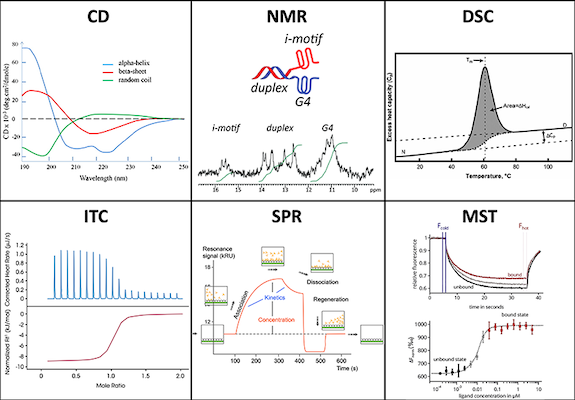
The research is focused on the study of noncanonical nucleic acids and their interactions with proteins or small molecules having potential biological activity. Another focus is the discovery of new DNA/RNA-based therapeutics. Our investigations are based on a combination of spectroscopic (NMR, CD, UV-vis, fluorescence, SPR, and MST), calorimetric (ITC and DSC), biochemical (protein expression), molecular biology (PCR, immunostaining), and chemometrics (PCA, MCR-ALS) techniques.
Research Team:
- Drug-NMR

Research activity of the Drug-NMR team is focused on the design, screening and optimization of compounds of interest in medicinal chemistry by the application of spectroscopic techniques as circular dichroism (CD) and nuclear magnetic resonance (NMR). The research consists in the study of interactions between ligands and macromolecular receptors, even on living cells, through both ligand- and macromolecule-detected NMR. Moreover, the team is involved in the study of the relationships between the 3D structure and the pharmacological activity of peptides and peptidomimetics.
Research Team:
COMPUTATIONAL CHEMISTRY
Development and application of structural bioinformatic approaches such as molecular docking and virtual screening, as well as quantum chemistry and molecular mechanics-based simulations techniques such as QM/MM, molecular dynamics (MD) and enhanced sampling methods. These methodologies are aimed both at identifying novel pharmaceutical compounds and at disclosing the thermodynamic and kinetic aspects of their binding mechanism. Biosimulations, alone or in combination with experimental techniques like NMR, are also applied either to the conformational analysis of peptides and peptidomimetics or to the investigation of protein-protein and protein-DNA interactions.
Research groups:
- DDLab
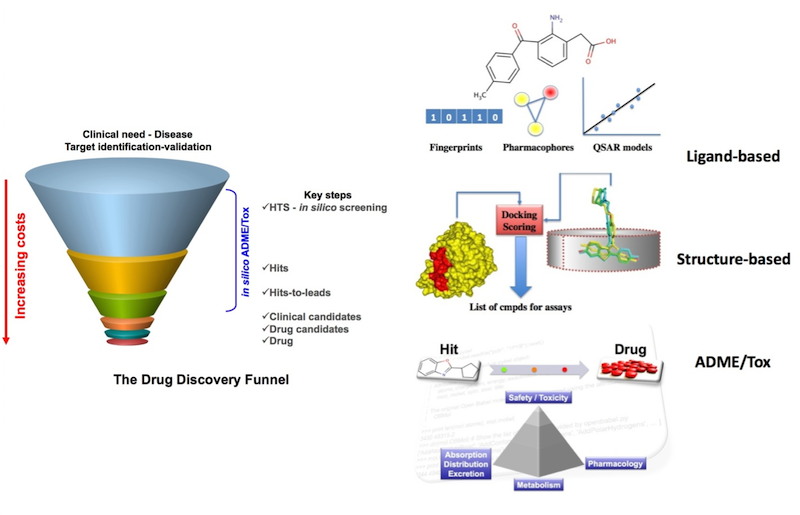
Our group is interested in developing and applying new computational approaches to accelerate the design and discovery of novel lead and drug candidates by integrating informatics, chemistry, biology, and medicine in an interdisciplinary fashion. Our research interests fall within several therapeutic areas, including metabolic diseases, cancer, inflammation, and other human pathologies. Currently, we are applying artificial intelligence technologies and large-scale data (big data) to support the different stages in the drug development process.
Research Team:
- BioSymDD
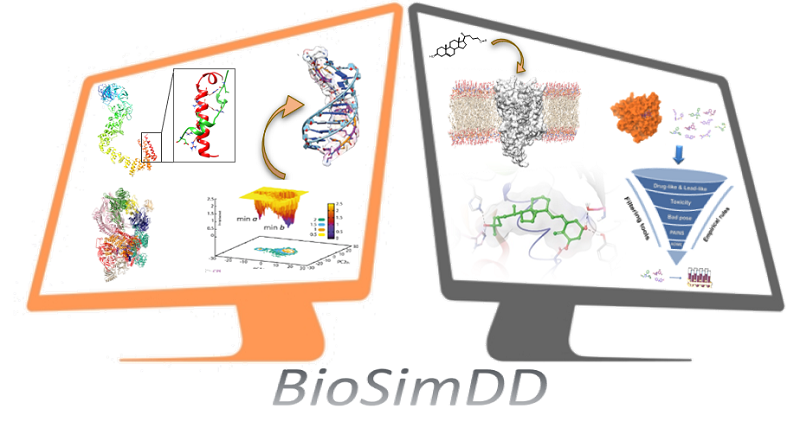
BioSymDD specializes in the use of the most modern computational techniques (virtual screening, docking and chemoinformatics, classical and advanced Molecular Dynamics) in the field of identification and optimization of new drugs, their mechanism of action and structure-activity relationships, as well as applied to biomolecular simulations for the study of allosteric effects of ubiquitination on complex proteins, and the study of complexes with nucleic acids.
Research Team:
- NeaCADD
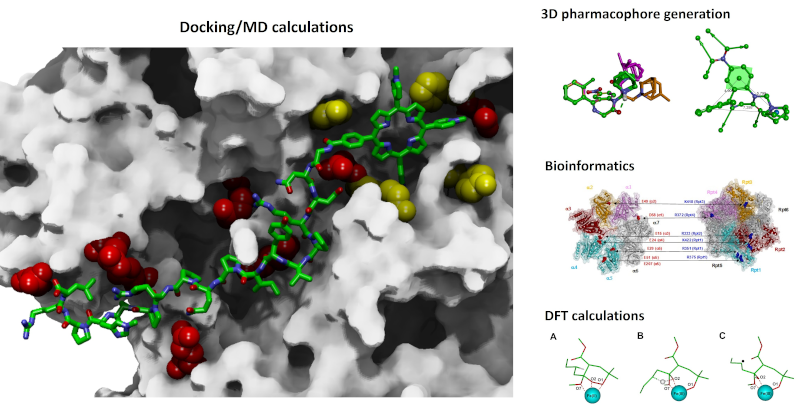
NeaCADD research group has a well-established experience in the field of computational medicinal chemistry, particularly skilled in the design of new potential therapeutic/diagnostic agents and in the investigation of their mechanism of action at the molecular level. Current areas of interest are related to a variety of therapeutic fields such as cancer, infectious, and neurodegenerative disease (protein conformational disorders).
Research Team:
- BioCODE
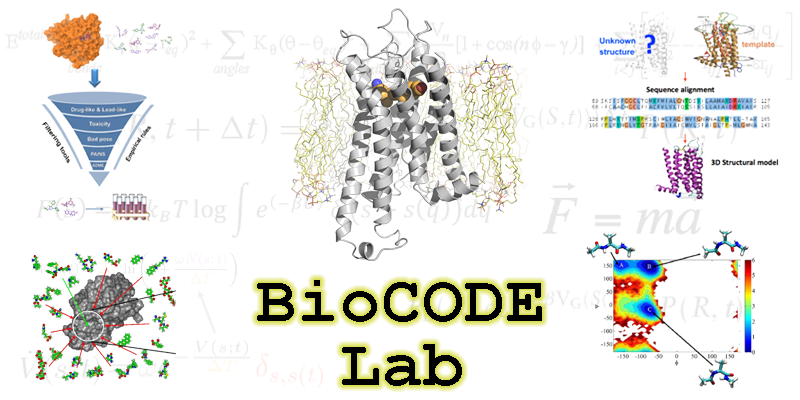
The expertise of the BioCODE Lab covers the development and application of both standard (i.e. molecular docking, virtual screening, molecular dynamics) and advanced (free energy methods, AI) bioinformatic and biosimulation techniques for the design and optimization of small molecules and peptides as novel potential drugs as well as for the thermodynamic and kinetic characterization of their interaction with the target macromolecule (protein or nucleic acid).
Research Team:
MARINELLI Luciana (PO)
DI LEVA Francesco Saverio (RTD-B)
LA PIETRA Valeria (RTD-B)
NATURAL PRODUCTS AND PHYTOCHEMISTRY
Isolation, structural elucidation and definition of the bio-pharmacological profile of bioactive compounds from animal and plant sources. Compounds of interest are selected based on their potential to be used as leads for the development of new drugs, for biotechnological applications or as ingredients in cosmetic formulations.
Research groups:
- LBM
The LBM group is interested in the identification of the molecular mechanisms underpinning the pharmacological properties of pure molecules (synthetic or natural) and of entire phyto complexes. We study the effects of these molecules on cell homeostasis, gene expression, mitosis, and several intracellular metabolic pathways. We are also interested in measuring their effects on intracellular organelles: Endoplasmic Reticulum, Golgi, Endosomes, Lysosomes, Plasma Membrane and Mitochondria.
Research Team:
- PHYTO

The research activity of Phytochemistry Group (PHYTO) is aimed at the isolation and structural characterization of metabolites from plants, selected on the basis of their bio-pharmacological potential, especially for the possibility of being used as lead compounds for the development of drugs. Some projects of the Phytochemistry Group are: a) molecules acting on the metabolic syndrome b) leads active against protozoal parasitosis. c) molecules acting on TRPs channels and/or cannabinoid receptors (CBs).
Research Team:
- MyComics
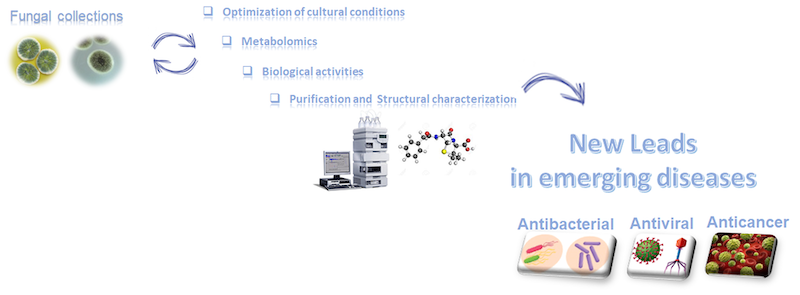
MyComics research activity is focused on the study of bioactive secondary metabolites isolated from selected marine fungi belonging to new or little studied (neglected species) taxa and showing poly-extremophilic features.
Marine fungi are studied, following a multidisciplinary approach (OSMAC and metabolomic techniques, isolation and structural characterization), for their ability to produce new secondary metabolites (SMs) active against emerging pathogens (virus, bacteria and fungi).
Research Team:
D'AURIA Maria Valeria
- NatLead
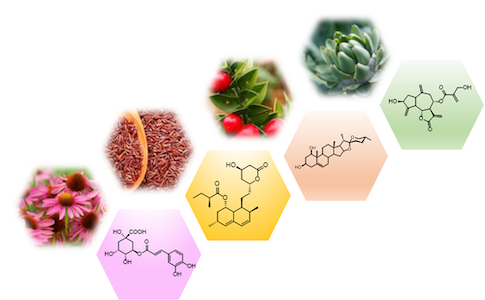
NatLead research project is focused on the isolation, structural characterization and biochemical decodification of secondary metabolites from plants of Mediterranean area with potential biological activity. Structural identification is performed trough the spectroscopic and spectrometric techniques. The bioactive compounds are further investigated to clarify their mechanism of action.
Research Team:
- The BlueChemistry Lab
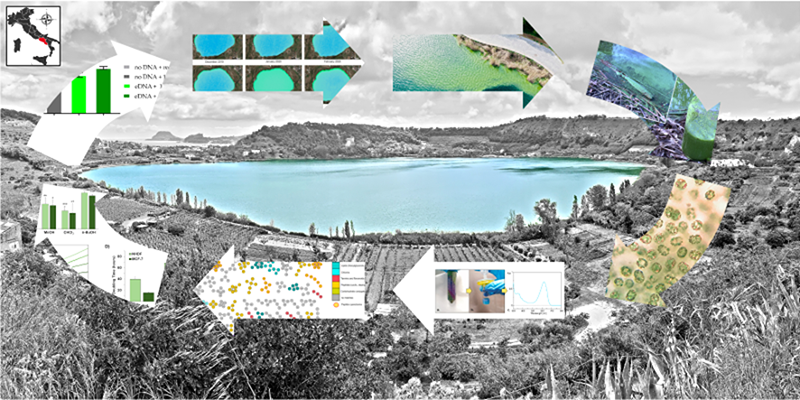
Study of cyanobacteria in the dual function of bioindicators of the state of environmental health and of bio-resource for the sustainable production of bioactive molecules.
Early monitoring of cyanobacterial blooms on the Mediterranean coasts and inland waters: the monitoring is carried out through an innovative multidisciplinary strategy (Fast Detection Strategy, FDS) that combines proximal or remote imaging with chemical and molecular analyzes.
keywords: marine-inspired molecules cyanobacteria, blooms, fast detection, bioindicators, siderophores, antifouling.
Research Team:
- SIDG
SIDG group (Sea Inspired Drug Group) focuses on exploring the chemodiversity generation by bioprospecting of marine organisms aimed at novel therapeutic approaches for human diseases. The projects in which SIDG is involved include a) identification of molecules with antitumor activities; b) hit to lead transition of identified molecules with antiparasitic properties; c) identification of polyketide and quinone molecules as selective and/or dual inhibitors of aldose reductase and PTP1B enzymes.
Research Team:
- NPBiotech

NPBiotech is involved in the bioprospecting of marine chemodiversity for the identification and sustainable production of new bioactive natural products (BNPs) as leads for new classes of anti-tumor and anti-inflammatory drugs. The key activities are: metabolic profiling of organisms by advanced computational methods (e.g. molecular networking); isolation of BNPs and their structural elucidation by spectroscopic and computational means; genome mining of micro-organisms for identification of biosynthetic genes for BNPs; sustainable production by fermentation of BNPs.
Research Team:
SYNTHESIS
Development and application of green and innovative synthetic methodologies yielding steroidal and/or heterocyclic small molecules, peptides, peptidomimetics, nucleobases, nucleic acids, and PNAs to be harnessed both as potential bioactive compounds and as building blocks for both biopolymers and smart delivery nanoplatforms.
- N.A.S.A. LAB
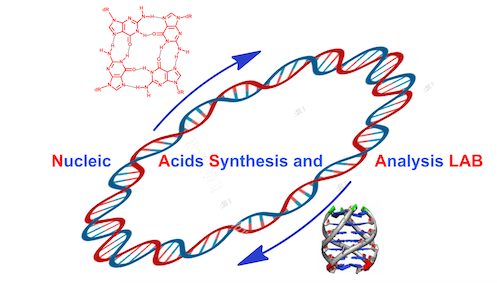
1) Design, synthesis and study of the chemical-physical and biological properties of aptamers and analogues forming G-quadruplex structures with anticoagulant, antiproliferative or antiviral activity; 2) Design, synthesis and study of the chemical-physical properties of G-quadruplex structures with catalytic activity aimed at the development of biosensors; 3) Design and synthesis of analogous RNAs for the regulation and study of miRNA and siRNA involved in pathological processes.
Research Team:
- GryMeCh Lab
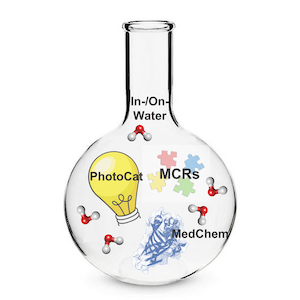
Development of green synthetic methodologies for the obtainment of biorelevant compounds. Application and development of multicomponent, photocatalytic, (photo)micellar (in-/on-water synthesis), and biocatalytic approaches to the targeting of anticancer pathways.
Research Team:
- PepBioMat
- Synthesis and characterization of bioactive peptides, PNA and metal complexes pharmacologically active.
- Formulation of nanomaterials (liposomes, micelles, hydrogels, nanogels and fibers.
- Derivatization of nanosystems with target selective peptide sequences, antibody or organic molecules.
- Loading of organic and inorganic drugs into nanosystems.
- Development of supramolecular contrast agents for bioimaging applications (Fluorescence, Magnetic Resonance Imaging, and nuclear medicine)
- Development and characterization (morphological and mechanical) of hydrogels for tissue engineering
Research Team:
- STARS
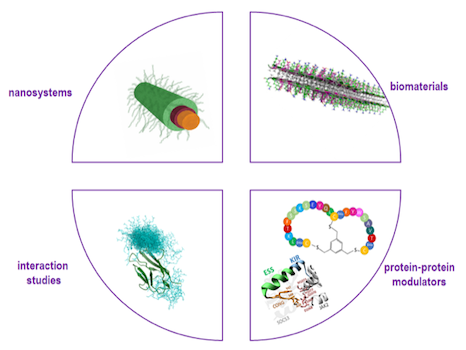
- Development and characterization of peptide systems for nanomedicine applications.
- Development of nanosystems with antibacterial and antiviral activity.
- Development of novel bioinspired materials based on self-assembling peptides for applications in personalized medicine.
- Interaction studies of biomolecules by NMR and computational methods.
- Identification of modulators of Protein-Protein Interactions: biochemical and biophysical characterization
Research Team:
- LiRiSyM
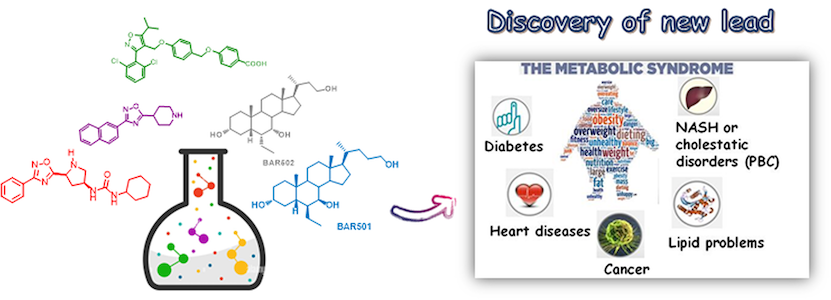
LiRiSyM research project is focused on the design and synthesis of new bile acids derivatives as modulators of receptors involved in metabolic syndrome. This research line is part of an agreement with BAR Pharmaceuticals. Recently, our research activity has also shifted towards the synthesis and development of heterocyclic compounds potentially useful for the treatment of metabolic and inflammatory disorders.
Research Team:
- Pep2Small Lab
Design (Structure-based and fragment based-drug design) and synthesis of small molecules, peptides and peptidomimetics as chemical probes to dissect biological functions of diverse molecular targets including membrane receptors, epigenetic targets, kinases and ubiquitin ligases E3. Development of innovative and eco-sustainable synthetic methodologies for the preparation of peptides and peptidomimetics.
Research Team:
- ModiLabs

Research Team:
- Nucleic Acids R&D
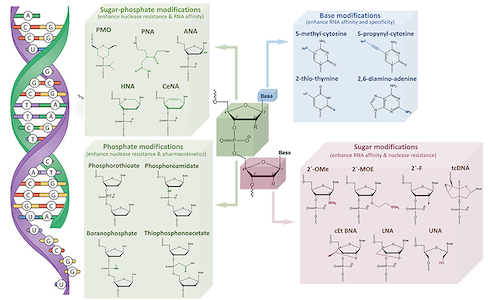
The research focuses on the design, chemical synthesis, and characterization of chemically modified oligonucleotides as novel therapeutic agents (aptamers, ASO, miRNA, siRNA). The research also focuses on the synthesis of optimized noncanonical nucleic acid targeting compounds to increase selectivity and specificity towards the target. Another focus is the synthesis and characterization of nucleic acid biosensors such as PNA and aptamers for the detection of DNA/RNA fragments or either biological or chemical species, respectively.
Research Team:
- SIDG
SIDG (Sea Inspired Drug Group) research activity is aimed at the development of marine natural scaffolds as leads for drug-design. SIDG expertise is focused on the design and synthesis of a) polyketide-like derivatives as selective and/or dual inhibitors of aldose reductase and PTP1B enzymes, emerging targets involved in the onset of chronic multifactorial diseases, such as T2DM, obesity, cancer, and inflammatory-based diseases; b) quinone leads active against parasitic infections.
Research Team:
- DREAMINESS
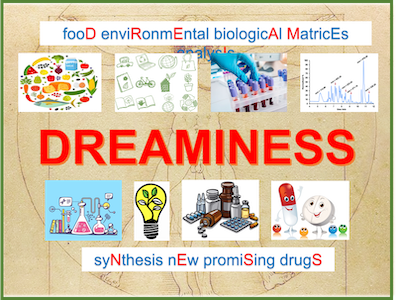
The research activity is devoted to the design, synthesis, and physicochemical characterization of small molecules and molecular hybrids (e.g. NO and H2S donors) acting against multiple targets. Furthermore, prodrugs aimed at improving the pharmacokinetic, pharmacodynamic and toxicological profiles of known drugs are developed. The synthetic strategy is carried out according to the principles of green chemistry and through the application of energy-efficient techniques.
Research Team:
- DeSynDrugs

The main research interests concern the design, synthesis, and characterization of: - serotonergic ligands; - modulators of the NCX exchanger isoforms; - protease inhibitors; - modulators of the H2S and S1P signal pathways.
The interest is also focused on the application of synthetic methods with high efficiency and reduced environmental impact, such as: - solid phase synthesis; -reactions in solvent free conditions; - microwave assisted reactions.
Research Team:
- SPOTS-LAB
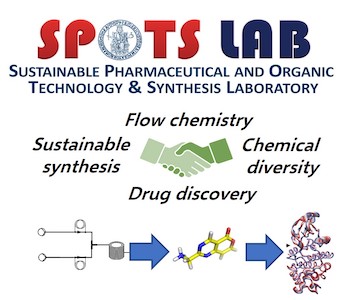
Implementation of green and sustainable chemical methodologies and application to drug discovery projects, with a special focus to anti-infective and antitumor agents. Application of continuous flow methodologies for the synthesis of heterocyclic/peptidomimentic compounds and active pharmaceutical ingredients (APIs).
Research Team:
- DIVE - Drug dIscoVery dEvelopment laboratory
Design, synthesis and characterization of small molecules, peptides, peptidomimetics, drug linkers, conjugates to small molecules and antibodies. Development of modern synthetic green methodologies. The research activities are supported by grants in collaboration with (inter)national groups, nonprofit organization, biotech and pharma companies. The major research therapeutic areas are antivirals, epigenetic modulators for rare, neurodegeneration and cancer diseases, precision medicine, and neglected diseases.
Research Team:
- SynBioLab
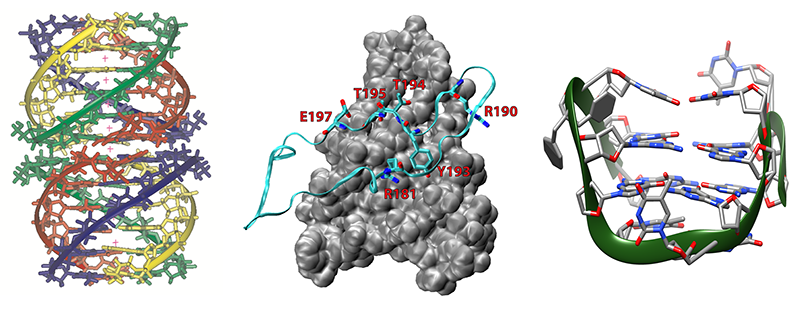
Design and synthesis of variously modified nucleic and peptide-nucleic acids. Variously modified DNA and PNA are realized as potential aptamers, as functional bioprobes, nanomaterials and as building blocks for the construction of new polymeric biomaterials.
Research Team: